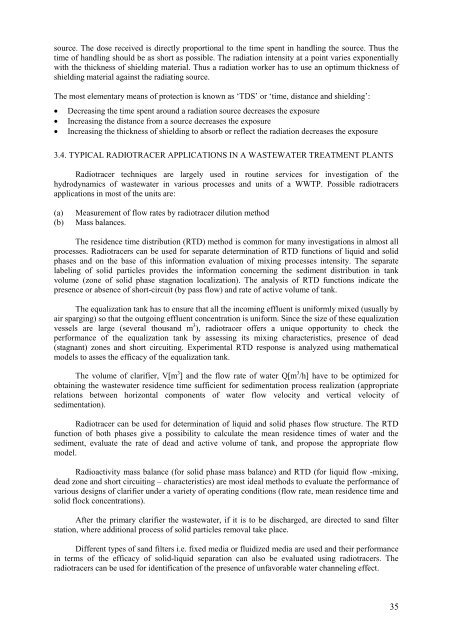Download file - Ayuntamiento de Zaragoza
Download file - Ayuntamiento de Zaragoza
Download file - Ayuntamiento de Zaragoza
Create successful ePaper yourself
Turn your PDF publications into a flip-book with our unique Google optimized e-Paper software.
source. The dose received is directly proportional to the time spent in handling the source. Thus thetime of handling should be as short as possible. The radiation intensity at a point varies exponentiallywith the thickness of shielding material. Thus a radiation worker has to use an optimum thickness ofshielding material against the radiating source.The most elementary means of protection is known as ‘TDS’ or ‘time, distance and shielding’:• Decreasing the time spent around a radiation source <strong>de</strong>creases the exposure• Increasing the distance from a source <strong>de</strong>creases the exposure• Increasing the thickness of shielding to absorb or reflect the radiation <strong>de</strong>creases the exposure3.4. TYPICAL RADIOTRACER APPLICATIONS IN A WASTEWATER TREATMENT PLANTSRadiotracer techniques are largely used in routine services for investigation of thehydrodynamics of wastewater in various processes and units of a WWTP. Possible radiotracersapplications in most of the units are:(a)(b)Measurement of flow rates by radiotracer dilution methodMass balances.The resi<strong>de</strong>nce time distribution (RTD) method is common for many investigations in almost allprocesses. Radiotracers can be used for separate <strong>de</strong>termination of RTD functions of liquid and solidphases and on the base of this information evaluation of mixing processes intensity. The separatelabeling of solid particles provi<strong>de</strong>s the information concerning the sediment distribution in tankvolume (zone of solid phase stagnation localization). The analysis of RTD functions indicate thepresence or absence of short-circuit (by pass flow) and rate of active volume of tank.The equalization tank has to ensure that all the incoming effluent is uniformly mixed (usually byair sparging) so that the outgoing effluent concentration is uniform. Since the size of these equalizationvessels are large (several thousand m 3 ), radiotracer offers a unique opportunity to check theperformance of the equalization tank by assessing its mixing characteristics, presence of <strong>de</strong>ad(stagnant) zones and short circuiting. Experimental RTD response is analyzed using mathematicalmo<strong>de</strong>ls to asses the efficacy of the equalization tank.The volume of clarifier, V[m 3 ] and the flow rate of water Q[m 3 /h] have to be optimized forobtaining the wastewater resi<strong>de</strong>nce time sufficient for sedimentation process realization (appropriaterelations between horizontal components of water flow velocity and vertical velocity ofsedimentation).Radiotracer can be used for <strong>de</strong>termination of liquid and solid phases flow structure. The RTDfunction of both phases give a possibility to calculate the mean resi<strong>de</strong>nce times of water and thesediment, evaluate the rate of <strong>de</strong>ad and active volume of tank, and propose the appropriate flowmo<strong>de</strong>l.Radioactivity mass balance (for solid phase mass balance) and RTD (for liquid flow -mixing,<strong>de</strong>ad zone and short circuiting – characteristics) are most i<strong>de</strong>al methods to evaluate the performance ofvarious <strong>de</strong>signs of clarifier un<strong>de</strong>r a variety of operating conditions (flow rate, mean resi<strong>de</strong>nce time andsolid flock concentrations).After the primary clarifier the wastewater, if it is to be discharged, are directed to sand filterstation, where additional process of solid particles removal take place.Different types of sand filters i.e. fixed media or fluidized media are used and their performancein terms of the efficacy of solid-liquid separation can also be evaluated using radiotracers. Theradiotracers can be used for i<strong>de</strong>ntification of the presence of unfavorable water channeling effect.35
















